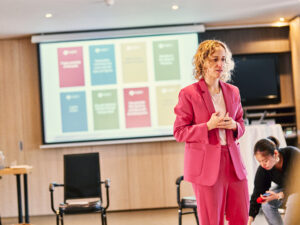At Beanmachine, we know that powerful learning environments make a difference – not just for us, but for organizations, too. To stay at the cutting edge, Bruno headed to Denmark for the “Designing & Facilitating Learning Spaces” course at Kaospilot. In the creative hub of Aarhus, he immersed himself in Learning Arch Design, a methodology that takes learning environments to the next level.
Why the jump to Denmark?
Every year, Beanmachine embarks on learning journeys abroad to gain fresh, pioneering insights. This year, Scandinavia was calling. According to Bruno, the Kaospilot program is a unique experience that equips facilitators to make a lasting impact.
5 biggest take-aways
Here, we’re sharing Bruno’s 5 biggest takeaways, designed to elevate your own learning programs.
Intentional Learners vs. Passive Participants
One of Bruno’s key insights? The power of creating “intentional learners” over passive participants. Design your learning space so that attendees feel ownership of their journey right from the start. Setting a strong context allows them to actively engage, turning them from consumers into drivers of their own learning experience.The Art of Learning Arch Design
Kaospilot’s core methodology revolves around creating a “learning arch” that maps the strategic goals and long-term purpose of a learning journey. From this big-picture arch, you build downwards into specific learning interventions that all align with the broader aim. This way, participants don’t just learn – they see the bigger picture.Reflection Matters: Learning by Doing
“We don’t learn from experience; we learn from reflecting on experience.” This insight is central to Kaospilot’s philosophy. Bruno learned that moments of reflection, even a chance to “redo” an exercise later, build stronger learning impact. At Beanmachine, we work with models like Kolb and ART-2R, but Kaospilot’s ideas bring a fresh boost to experiential learning.“Not Intervening is Also an Intervention”
Trainers often feel the urge to step in when participants hit a roadblock. But Bruno found that sometimes the most impactful choice is not to intervene. By letting participants work through their moments of frustration and confusion, you give them the gift of their own journey. It’s counterintuitive – but, when given the space, participants grow in ways a quick fix simply can’t provide.The Power of Duo-Facilitation
As a facilitator, you juggle content, group dynamics, and process – all at once. Kaospilot introduces “cybernetics” through duo-facilitation, where one facilitator manages the “above the surface” aspects (content and flow) while the other observes the “below the surface” dynamics of the group. It’s a potent approach for deep, effective facilitation.
Want to see these insights in action?
From February 3th-5th 2025, we’re bringing this course to Leuven! Together with Kaospilot, we’ll be hosting the “Designing & Facilitating Learning Spaces” course close to home, giving facilitators and learning designers the opportunity to master methods that make a lasting impact.





